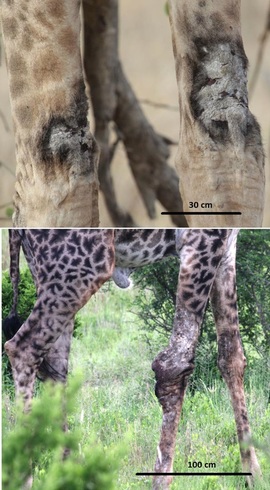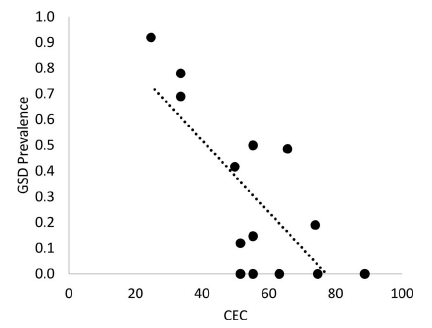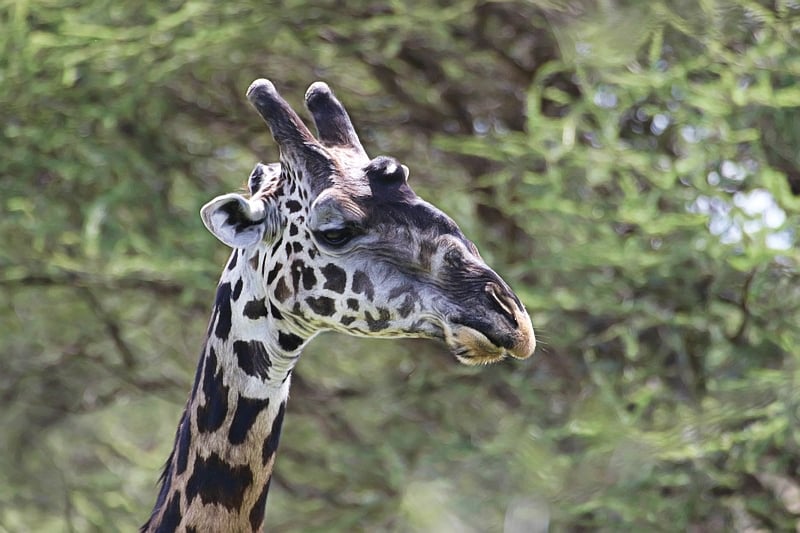 Giraffe Skin Disease is a disorder of the skin that is characterized by crusty lesions on the back side of the front legs of adult Masai giraffe (Giraffa camelopardalis tippelskirchi) the only subspecies in Tanzania. Lesions such as the ones shown in this picture on the forelimbs indicate Giraffe Skin Disease. Giraffe Skin Disease was first recorded 12 years ago in Ruaha National Park in central Tanzania. Since then, the disease has spread to parts of northern Tanzania, including Tarangire and Serengeti National Parks. Very little was known about how many giraffes have this disease, and how it affected their survival. So, scientists with Wild Nature Institute estimated prevalence (% affected) in national parks and conservation areas throughout northern Tanzania. They also examined incidence (rate of spread among individuals), and mortality (difference in survival between affected and non-affected giraffe) in the Tarangire-Manyara Ecosystem. Wild Nature Institute continues to share the knowledge gained from our research with local land managers, wildlife authorities, and community leaders so we can help develop and implement effective disease-mitigation strategies and prioritize the spending of scarce wildlife conservation dollars towards where they are needed most.
Giraffe Skin Disease is a disorder of the skin that is characterized by crusty lesions on the back side of the front legs of adult Masai giraffe (Giraffa camelopardalis tippelskirchi) the only subspecies in Tanzania. Lesions such as the ones shown in this picture on the forelimbs indicate Giraffe Skin Disease. Giraffe Skin Disease was first recorded 12 years ago in Ruaha National Park in central Tanzania. Since then, the disease has spread to parts of northern Tanzania, including Tarangire and Serengeti National Parks. Very little was known about how many giraffes have this disease, and how it affected their survival. So, scientists with Wild Nature Institute estimated prevalence (% affected) in national parks and conservation areas throughout northern Tanzania. They also examined incidence (rate of spread among individuals), and mortality (difference in survival between affected and non-affected giraffe) in the Tarangire-Manyara Ecosystem. Wild Nature Institute continues to share the knowledge gained from our research with local land managers, wildlife authorities, and community leaders so we can help develop and implement effective disease-mitigation strategies and prioritize the spending of scarce wildlife conservation dollars towards where they are needed most.
Research from Wild Nature Institute scientists published in the Journal of Wildlife Diseases documented ‘Soil correlates and mortality from Giraffe Skin Disease in Tanzania.’ This is the most recent step in ongoing investigations into this emerging disease. Previous work by Wild Nature Institute scientists found an interesting spatial pattern in the prevalence of the disease. The later results built on these earlier findings and found Giraffe Skin Disease was most prevalent on low fertility soils (as measured by cation exchange capacity or CEC, a common measurement of soil fertility). If parasites such as nematodes or tsetse flies are involved in Giraffe Skin Disease, differences in soil may influence the ground-dwelling life stages of these organisms. Soil characteristics may also impact the nutritional status of giraffes through vegetation quality, thus affecting their susceptibility to the disease.
Giraffe Skin Disease was most prevalent on low fertility soils.
We found no mortality effect of Giraffe Skin Disease in Tarangire National Park, animals with GSD lesions had the same survival rate as animals without lesions, indicating that currently Giraffe Skin Disease is unlikely to warrant immediate veterinary intervention in this park. Movement of infected giraffe remains an unexplored aspect of Giraffe Skin Disease effects, but limited mobility could lead to lower survival or reproduction if climate, habitat, or predation factors change from current conditions in Tarangire. Monitoring in Tarangire will continue to ensure early detection if Giraffe Skin Disease-afflicted animals begin to show signs of increased mortality or other negative effects.
There is work underway at the National Zoo and Tufts University to better understand the causative agent.

